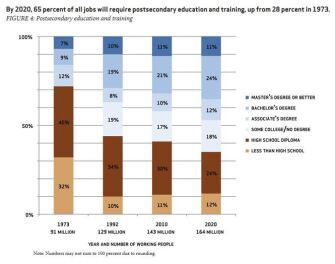Cross-posted from Marketplace K-12.
UPDATED
States are approving policies to promote career and technical education at a rapid pace, often encouraging businesses and industries to help shape programs or provide internships, according to a recent report from the Education Commission of the States.
In a 50-state survey, the commission found that at least 78 substantive policy changes were made in 2013 by states to promote career and technical education, an area of study once known as vocational education, and now often called “CTE” for short. Those policies came in the form of legislation, state board rules, and executive orders designed to strengthen workforce development. One of the factors driving policymakers’ interest is their conviction that high-skilled workers are needed for states to compete in the global economy, according to the “Career and Technical Education: States Aligning Programs to Meet Workforce Needs” report.
“Last year there was a definite uptick in policies at the high school and secondary levels to prepare for jobs that are going unfilled,” said report author Jennifer Dounay Zinth, a senior policy analyst at the Denver-based research and policy organization, in an interview. “Looking across even the first two months of this legislative session, it’s clear there’s a specific role for business and industry in creating internships and apprenticeships to work with K-12 and secondary partners.”
This spring, for instance, Indiana authorized its economic development corporation to award grants to applicant school districts and charter schools for cooperative arrangements with businesses for training students. Employers who hire successful students in high-wage, high-demand jobs requiring industry certification may apply for a tax credit for each such hired worker.
In Kansas, districts are even receiving cash incentives for students who demonstrate workforce capabilities after completing certain programs. Kansas public and private high schools have received a $1,000 incentive reward for each student who graduates with industry-recognized credentials in an occupation that is considered “high need” for more qualified people to do that type of work. Last year, $686,000 was paid to public schools and $17,000 to private schools under this program, with certified nurse’s aides representing the largest occupational certification, at 81 percent of students graduating from qualified programs.
The demand for students holding postsecondary education and training is on the rise, as indicated by this chart from the “Recovery: Job Growth and Education Requirement Through 2020" report published in June 2013 by Georgetown University’s Center on Education and the Workforce indicates.

U.S. Census statistics show that adult workers with “alternative credentials,” such as professional licenses and certificates outside associate’s or bachelor’s degree credentials, have more employment stability and higher earnings than adults without such a credential, according to the Education Commission of the States report.
Examples of states’ efforts to promote career and technical education and workforce development include:
- Florida has paved the way for the creation of CTE-specific governing boards with members—and potentially leaders—from business and industry.
- Alabama created a workforce council that will allow for collaboration with business and industry, and an evaluation of public-private partnerships, as well as industry-funded scholarships.
- North Carolina has directed local school administrators to consult with industries, employers, and workplace-development boards in the region to see how to best meet state and local workforce needs.
- Louisiana created a “Jump Start” model to encourage public-private partnerships with school districts, two-year colleges, local industries, and economic and workforce development experts to come up with its own statewide credentials, with courses and work-based experiences based on curricula and assessments from industry credentialing organizations.
- Indiana created a center for education and career innovation, for which a request for proposal has been released to develop an “innovative career and technical education curriculum.”
[UPDATE (3:35 p.m.): Of all the changes made by states in 2013, the most common one was directing more funding to support new and existing CTE initiatives, which occurred in 31 states, according to “State Policies Impacting CTE: 2013 Year in Review,” a different report released last month by the National Association of State Directors of Career Technical Education Consortium and the Association for Career and Technical Education. Beyond that, 14 states changed governance of career and technical education by reorganizing their state agencies, clarifying regulatory authority for CTE, or launching statewide task forces or councils to coordinate efforts. Thirteen states changed graduation requirements in ways that will impact CTE students, and 13 expanded access to dual/concurrent enrollment for students interested in career technical education.]
The full report from the Education Commission of the States is available here. In addition, the organization offers access to databases it updates regularly, including CTE tracking, which has a breakout for policies about career academies and apprenticeships, The commission also tracks economic and workforce development legislation, rules and regulations, and/or executive orders.
